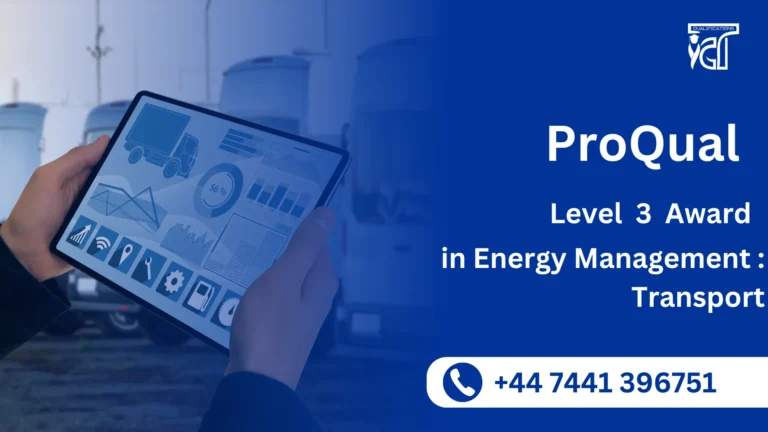The ProQual Level 4 Certificate in Advance Fire Risk Assessment is a specialized qualification designed for fire safety professionals and risk management practitioners aiming to enhance their expertise. This advanced program equips learners with the knowledge and practical skills needed to carry out thorough fire risk assessments, identify hazards, evaluate potential threats, and implement effective fire prevention and mitigation strategies in line with national legislation and compliance standards.
This certificate is particularly valuable for fire risk assessors, health and safety managers, facilities managers, fire safety officers, and consultants responsible for ensuring safety across commercial, industrial, and public sector buildings. Graduates of this course gain the competence to produce professional, legally compliant fire risk assessment reports that align with both regulatory and organizational safety requirements.
The curriculum covers advanced methodologies in fire risk assessment, fire prevention techniques, passive and active protection systems, and management of fire safety in high-risk buildings. Learners also develop an understanding of human behavior, building materials, and occupancy factors to ensure a comprehensive approach to fire safety management.
By achieving the ProQual Level 4 Certificate in Advanced Fire Risk Assessment, professionals not only strengthen their career prospects but also earn industry recognition and the confidence to make informed decisions in complex fire safety situations. This qualification empowers individuals to play a proactive role in minimizing fire risks, safeguarding people and property, and promoting safer workplace environments.
Whether your objective is career progression, enhancing workplace safety, or boosting your professional standing, this certificate delivers the practical skills, advanced knowledge, and confidence required to excel in the fire risk management field..
ProQual Level 4 Certificate in Advance Fire Risk Assessment
The ProQual Level 4 Certificate in Advance Fire Risk Assessment consists of 3 units :
- Principles of the Advanced Fire Risk Assessment
- Practice of the Advanced Fire Risk Assessment
- Supporting and Supervising Others Carrying out Fire Risk Assessments
GLH (Guided Learning Hours) and TQT (Total Qualification Time) are terms commonly used in vocational qualifications to help define the amount of time a learner is expected to spend on their studies.
1. GLH (Guided Learning Hours)
GLH refers to the number of hours a learner spends being directly taught, supervised, or supported during their course. This includes the time spent in activities such as:
- Classroom instruction
- Practical workshops
- One-on-one tutoring or mentoring sessions
- Online learning sessions with tutor support
In other words, GLH represents the time that learners are actively engaged with their instructors or learning activities.
2. TQT (Total Qualification Time)
TQT represents the total amount of time a learner is expected to invest in completing a qualification, including:
- GLH (Guided Learning Hours): Time spent on direct learning, as explained above.
- Self-Directed Learning: This includes time spent on independent study, research, assignment completion, preparation for exams, and any other work the learner does outside of direct teaching hours.
TQT is a broader measure that includes all the time required to achieve the qualification. It helps learners and employers understand the overall commitment required for the qualification.
Key Differences Between GLH and TQT:
- GLH focuses on direct learning with guidance or supervision.
- TQT includes GLH as well as independent study time and other learning-related activities.
Example:
If a qualification has a TQT of 600 hours and a GLH of 250 hours, it means the learner should spend 250 hours in direct learning (classroom, online, or tutor-led sessions) and 350 hours on independent study or research.
Upon completing this Course students will be able to:
Understand Legislation and Guidance Relevant to Advanced Fire Risk Assessment
- Describe the relevant legislative national framework, in relation to fire safety, for the country in which you are carrying out fire risk assessments.
- Identify guidance documents that are relevant to the Advanced Fire Risk Assessment.
- Explain the purpose of the guidance documents that are relevant to the Advanced Fire Risk Assessment.
- Explain the difference between regulation and guidance.
- Describe the legal requirements placed on:
- Responsible persons
- Duty holders
- Relevant regulators
Understand the Principles of Fire Risk Assessment for High-Risk Buildings
- Describe the common causes of fire in various high-risk buildings.
- Identify common causes of fire spread in various high-risk buildings.
- Explain, with examples, the different types of high-risk building.
- Describe the different types of occupants within high-risk buildings.
- Explain why it is important to consider human behaviour when conducting a fire risk assessment.
- Evaluate the fire resisting properties of three types of material used in construction and explain how their use affects the fire safety of a building.
Understand the Control Measures Used to Reduce the Risk of and from Fire
- Identify common fire prevention activities that could be applied to a high-risk building.
- Identify fire safety management systems that could be appropriate for a high-risk building.
- Describe the types and purposes of passive fire protection systems that might be present in a high-risk building.
- Describe the types and purposes of active fire protection systems that might be present in a high-risk building.
Understand How to Develop and Update Own Knowledge of Fire Risk Assessment
- Identify sources of information that could be used to reflect on and inform own practice, in relation to the fire risk assessment of high-risk buildings.
- Reflect on own understanding of the professional and ethical standards, including identification of areas for improvement.
- Describe how areas of weakness, in relation to current knowledge and skills, can be addressed.
- Produce a CPD plan to address current areas of weakness and to ensure own knowledge is kept up to date, including:
- Identify appropriate CPD activities
- Timescales
- How development of knowledge and practice will be reviewed
Benefits of the ProQual Level 4 Certificate in Advance Fire Risk Assessment
Earning this qualification offers numerous practical and professional benefits:
Enhanced Professional Knowledge and Skills
- Gain advanced expertise in fire risk assessment, hazard identification, and risk evaluation.
- Develop practical skills to implement effective fire prevention and mitigation strategies.
Compliance with Legislation
- Learn to apply current national fire safety laws and guidance.
- Ensure fire risk assessments and safety measures meet legal and professional standards.
Practical, Real-World Application
- Conduct risk assessments for high-risk buildings using proven methodologies.
- Produce detailed, professional fire risk assessment reports for organizations.
Career Progression and Recognition
- Strengthen your professional profile in fire safety and risk management.
- Enhance opportunities for promotion or consultancy roles in the industry.
Improved Fire Safety Management
- Learn to design and implement comprehensive fire safety strategies.
- Understand and apply both passive and active fire protection systems effectively.
Continuous Professional Development (CPD)
- Equip yourself with tools to maintain and update knowledge through ongoing CPD.
- Ensure your skills remain current and relevant in a changing fire safety landscape.
Increased Confidence in Decision-Making
- Evaluate complex fire risks and implement proactive mitigation measures.
- Provide professional guidance on fire safety to organizations and stakeholders.
Proactive Risk Management
- Take a leading role in creating safer work environments.
- Contribute to safeguarding employees, visitors, and the public from fire hazards.
The ProQual Level 4 Certificate in Advance Fire Risk Assessment is designed for professionals involved:
Fire Risk Assessors
- Professionals responsible for identifying fire hazards and evaluating risks.
- Individuals seeking to deepen their expertise in advanced fire risk assessment techniques.
Health and Safety Managers
- Professionals managing workplace safety across commercial, industrial, or public buildings.
- Those aiming to strengthen knowledge of fire safety legislation and compliance.
Building and Facilities Managers
- Managers responsible for maintaining fire safety standards in various facilities.
- Individuals seeking to implement robust fire prevention and mitigation strategies.
Fire Safety Officers and Consultants
- Professionals providing guidance and consultancy on fire safety management.
- Those aiming to gain professional recognition and credibility within the fire safety industry.
Workplace Safety Professionals
- Individuals responsible for ensuring safe environments for employees, visitors, and the public.
- Professionals seeking to integrate advanced fire risk management into organizational safety plans.
Career Development and Progression Seekers
- Professionals looking to advance careers in fire safety, risk management, or health and safety roles.
- Individuals aiming to gain practical skills, confidence, and professional recognition in fire risk assessment.
Future Progression – ProQual Level 4 Certificate in Advanced Fire Risk Assessment
Completing the ProQual Level 4 Certificate in Advanced Fire Risk Assessment opens the door to a wide range of career and academic progression opportunities. This Ofqual-regulated qualification not only enhances your professional credibility but also sets the foundation for higher-level learning and senior roles in fire safety and risk management.
- Progress to Higher Qualifications: Learners can advance to Level 5 Diplomas in Fire Safety, Health and Safety, or Risk Management, further strengthening their expertise.
- Specialized Training Pathways: Opportunities to specialize in fire safety auditing, compliance management, and advanced building risk assessments.
- Career Advancement: Qualify for senior positions such as Fire Risk Assessor (Advanced), Fire Safety Manager, Compliance Officer, or Fire Safety Consultant.
- Broader Opportunities: Transition into related fields like Health & Safety Management, Environmental Risk Management, or Building Compliance.
- International Recognition: This qualification is highly respected worldwide, allowing professionals to pursue fire safety roles in different countries.
- Chartered Status Pathways: Supports progression towards professional memberships with recognized bodies in fire safety and health and safety.
By achieving this qualification, learners position themselves as highly skilled professionals capable of managing complex fire safety challenges, ensuring compliance, and protecting both people and property.
Entry Requirements
To be eligible for this qualification, learners are expected to meet the following entry requirements :
Register Now
Qualification Process
Qualification Process for the ProQual Level 4 Certificate in Advance Fire Risk Assessment
- Self-Assessment:
Begin by evaluating your eligibility to ensure you meet the qualification requirements, including work experience, knowledge, and language proficiency. - Registration:
Complete your registration by submitting the required documents, including a scanned copy of a valid ID, and paying the registration fee. - Induction:
An assessor will conduct an induction to confirm your eligibility for the course and explain the evidence requirements. If you do not meet the criteria, your registration will be canceled, and the fee will be refunded. - Assignments & Evidence Submission:
Provide all assignments and the necessary evidence based on the assessment criteria outlined in the course. If you are unsure of the required evidence, consult with the assessor for guidance on the type and nature of evidence needed. - Feedback and Revision:
The assessor will review your submitted evidence and provide feedback. Evidence that meets the criteria will be marked as “Criteria Met,” while any gaps will be identified. You will be asked to revise and resubmit if needed. - Competence Evidence:
Submit final evidence demonstrating that all learning outcomes have been met. This evidence will be marked as “Criteria Met” by the assessor once it is satisfactory. - Internal Quality Assurance (IQA):
The Internal Quality Assurance Verifier (IQA) will review your evidence to ensure consistency, quality, and compliance with standards. - External Verification:
The IQA will submit your portfolio to ProQual External Quality Assurance Verifiers (EQA) for final confirmation. The EQA may contact you directly to verify the authenticity of your evidence. - Certification:
Upon successful completion of all checks, ProQual will issue your official certificate, confirming that you have attained the ProQual Level 4 Award in the External Quality Assurance of Assessment Processes and Practice.
FAQs for ProQual Level 4 Certificate in Advance Fire Risk Assessment






